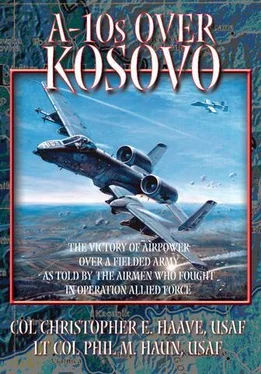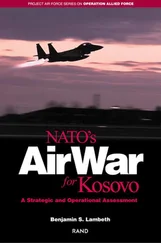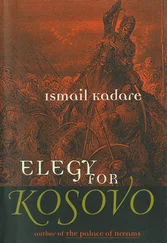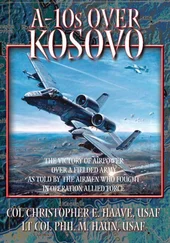23 May
NATO begins a bombing campaign against the Yugoslav electricity grid, creating a major disruption of power that affects many militaryrelated activities and water supplies.
The 104th EOG begins to fly missions out of Trapani AB, Sicily.
31 May
1st Lt Hummer Cerone and 1st Lt Co Martin pass their flight-lead check rides and pin on captain bars.
8 June
The West and Russia reach a landmark agreement on a draft UN resolution at the annual meeting of the heads of state of the eight major industrial democracies (G8) in Cologne, France. NATO calls on Milosevic to resume military talks on troop withdrawal at once.Talks between senior NATO and FRY officers on a Serb pullout from Kosovo resume in Macedonia and continue into the night.
9 June
This is the last day authorized for NATO forces to expend ordnance.
Slobodan Milosevic capitulates and agrees to withdraw forces from Kosovo.*
Maj James “Jimbo” MacCauley and 1st Lt Scud Curley are shot at by mobile SAMs, return the attack, and score a probable SAM kill.*
Col Al Thompson attacks armored personnel carriers (APC) near Mount Osljak.*
Military talks continue with senior NATO and FRY officers. Late in the day, the two parties sign the Military Technical Agreement.
10 June
Secretary General Solana calls for a suspension of NATO air strikes after receiving definite evidence that Serb forces are withdrawing from northern Kosovo. The UN Security Council adopts Resolution 1244 on Kosovo. In Cologne, G8 ministers draft a plan to anchor the Balkans to Western Europe and rebuild Kosovo.
11 June
Col Al Thompson passes command of the 40th EOG to Col Gregg Sanders and returns to Spangdahlem.*
20 June
In accordance with the 9 June Military Technical Agreement, Serb forces completely withdraw from Kosovo, leading Secretary General Solana to officially end NATO’s bombing campaign in the Former Republic of Yugoslavia.
30 June
A-10s cease CSAR and close air support (CAS) alert as NATO occupation forces enter the KEZ.*
2000
6 October
Milosevic concedes defeat in the presidential election to Vlajislav Kostunica. Milosevic gives up power after widespread protests and Russian urging.
2001
29 June
Prime Minister Zoran Djindjic of Serbia invokes Yugoslavia’s obligations under international law to support the transfer of Milosevic to the UN war crimes tribunal at The Hague. Milosevic is charged with committing crimes against humanity in Kosovo and Croatia. In November 2001, the charge of genocide is added, stemming from his alleged activity during the 1992–95 Bosnian war.
2002
12 February
Milosevic’s trial begins in The Hague with Milosevic acting as his own defense lawyer. He is the first head of state to face an international warcrimes court.
Chapter 1.
THE A-10, ITS MISSIONS, AND THE HOG UNITS THAT FLEW IN OPERATION ALLIED FORCE
Lt Col Chris “Kimos” Haave
The A-10 Thunderbolt II is the last in a long line of fighter and attack aircraft named “Thunder,” which were built by the Fairchild Republic Aircraft Company of Farmingdale, New York. Its notable ascendants include its namesake the P-47 Thunderbolt, the F-84 Thunderjet, the F-84F Thunderstreak, and the storied F-105 Thunderchief, whose name was familiarly abbreviated to “Thud.” The Thunderbolt II was developed to provide close air support (CAS) and improve on the Air Force’s experience with the reliable Vietnam War–era Douglas A-1E “Skyraiders.” The A-1E was a rugged and versatile ground-attack fighter that could loiter for extended periods in the target area and effectively employ a wide variety of air-to-ground weaponry. These attributes well served the CAS and combat search and rescue (CSAR) mission needs; pilots flying the A-1E on CSAR missions were first to use the “Sandy” call sign. To provide similar capabilities, the A-10 was designed as a straight-wing, subsonic attack aircraft uniquely equipped with an internal seven-barrel GAU-8 30 millimeter (mm) Gatling gun. It can also employ a large variety of weapons—including AGM-65 Maverick missiles—and can defend itself with air intercept missiles (AIM). Early in its history, the A-10’s appearance earned it the beloved nickname “Warthog,” which is often shortened to “Hog.” Many A-10 units have unofficial patches or coffee mugs with the motto “Go Ugly Early”—a testimony to its unique allure and the affection felt by those associated with it.
\Photo: A-10 Thunderbolt II, …Warthog, …Hog
The nomenclature of the A-10 is often confusing because the designations “A-10,” “OA-10,” and “A/OA-10” have been used to identify essentially identical aircraft. In reality, the aircraft designation reflects its assigned mission and the qualification of its pilot. “A-10” normally identifies an aircraft dedicated to the CAS mission, while “OA-10” refers to one used in the airborne forward air controller (AFAC) role. Each unit’s aircraft is then designated either A-10 or OA-10 as a reflection of the weighting of that unit’s CAS and AFAC tasking. Fighter squadrons (FS) must maintain an appropriate number of pilots qualified in each of those missions in addition to those qualified for CSAR, which is not directly related to either aircraft designation. During Operation Allied Force (OAF), Warthog squadrons were tasked for all three missions; and in accordance with standard Air Force nomenclature, they were identified as flying the “A/OA-10.” In this book, however, we use the convention “A-10” for all Hogs, regardless of squadron, tail number, or mission.
Current A-10 Roles and Missions
The number and complexity of A-10 missions have increased dramatically since the end of the Cold War. Until Operation Desert Storm, Hog squadrons trained almost exclusively for high-intensity combat against Warsaw Pact–style integrated air defense systems (IADS) and massed armor formations. As a result, A-10 pilot training and weapons loads were optimized for daytime, low-altitude CAS missions in joint operations with Army units. In addition, A-10 pilots practiced some daytime, low-altitude air interdiction (AI). Night flying focused on in-flight refueling and instrument flying to facilitate deployments. Only those highly qualified pilots who had attended weapons school (the United States Air Force [USAF] Fighter Weapons Instructor Course) were qualified for CSAR missions. The remaining unit pilots, even the very experienced ones, had no CSAR training.
The A-10 picked up the AFAC mission in the late 1980s as the Air Force retired the OV-10 and OA-37 from its active inventory. The Hogs were designated as OA-10s, formed into tactical air support squadrons, and flew the AFAC mission exclusively, as had the OV-10 and OA-37 units before them. Pilots in OA-10 units were not qualified in ground-attack missions and generally did not carry offensive air-to-ground weapons. In Operation Desert Storm separate A-10 and OA-10 squadrons were tasked and employed in attack and AFAC roles. That changed in 1995, and from that point forward all A-10 squadrons became responsible for all A-10 missions.
During Operations Desert Shield and Desert Storm, A-10 squadrons developed tactics for medium altitude and night employment in response to post–Cold War changes in threats, targets, and geography specific to the Southwest Asian theater and its particular circumstances. Since then, the emphasis in A-10 tasking and tactics development has continued to steadily move from only daytime, low-altitude missions towards daytime and nighttime, medium-altitude missions.
Читать дальше












